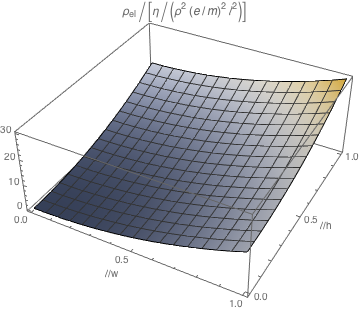We calculate the viscous resistance of a bar with width $w$, height $h$, and length $\ell$. We show that the scaling of the resistance with the sample geometry is approximately
$$ R\sim \frac{\ell}{wh}\left(\frac1{w^2}+\frac1{h^2}\right) $$
Resistance of a bar
Regarding the electrons (charge $-e$, effective mass $m$) as a viscous
fluid with dynamic viscosity $\eta$ and mass density $\rho$, we solve
the Navier-Stokes equations
\[\eta\Delta v+\rho\frac em\nabla\phi=0\]
for the velocity field $v$ in the high-viscosity limit (laminar flow, stationary solution), like the Hagen-Poiseuille flow.
For a bar with width $w$, height $h$, and length $\ell$ the
electrostatic potential $\phi$ describes a constant electric field
generated by applying a voltage $V$ along the $z$ direction,
\[\phi=-V\frac z\ell.\]
We assume that the boundaries of the bar are perfectly rough such that the
component of the drift velocity $v$ parallel to the boundary
vanishes. Introducing a parameter
\[\gamma:=-\frac{e/m}{\eta/\rho}\frac{\partial}{\partial z}\phi
=\frac{e/m}{\eta/\rho}\frac V\ell\]
and denoting with $v$ the $z$ component of the drift velocity from now on the Navier-Stokes equations
boil down to solving Poisson’s equation
\[\Delta v=\gamma,\quad(x,y)\in\Omega\]
subject to the Dirichlet boundary condition
\[v=0,\quad(x,y)\in\partial\Omega\]
where $\Omega$ denotes the rectangular region $0\le x\le w\land0\le y\le
h$ for arbitrary but constant $z$.
General solution by series expansion
This problem has a formal solution expressing $\gamma$ by a Fourier series
expansion in terms of the eigensystem \(\{\phi_{mn},\lambda_{mn}\}\) of the
Laplacian with
\[(\Delta-\lambda_{mn})\phi_{mn}=0.\]
We can write
\[\begin{align*}
\gamma
&=
\sum_{m=1}^\infty\sum_{n=1}^\infty\gamma_{mn}\phi_{mn},
\\
\gamma_{mn}
&=
\frac{\int_\Omega\gamma\phi_{mn}^*{\rm d}A}
{\int_\Omega\left\vert\phi_{mn}\right\vert^2{\rm d}A},
\end{align*}\]
which is in principle valid for arbitrary (suitably well behaved) functions
$\gamma=\gamma(x,y)$, not just the constant used here. We express the
drift velocity $v(x,y)$ in terms of the eigenfunctions as well,
\[v=\sum_{m=1}^\infty\sum_{n=1}^\infty v_{mn}\phi_{mn}\]
and insert this into our main equation $\Delta v=\gamma$ from above to
get
\[\sum_{m=1}^\infty\sum_{n=1}^\infty\lambda_{mn}v_{mn}\phi_{mn}
=
\sum_{m=1}^\infty\sum_{n=1}^\infty\gamma_{mn}\phi_{mn}.\]
Termwise comparison tells us that \(v_{mn}=\gamma_{mn}/\lambda_{mn}\), and
we have the desired answer,
\[v=\sum_{m=1}^\infty\sum_{n=1}^\infty\frac{\gamma_{mn}}{\lambda_{mn}}\phi_{mn}.\]
Eigensystem of the Laplacian
The eigensystem of the Laplacian with the boundary conditions given above
is obviously given by
\[\begin{align*}
\phi_{mn}&=\sin\left(\pi mx/w\right)\sin\left(\pi ny/h\right),\\
\lambda_{mn}&=\pi^2\left((m/w)^2+(n/h)^2\right),
\end{align*}\]
and we get
\[\begin{align*}
\int_\Omega\left\vert\phi_{mn}\right\vert^2{\rm d}A
&=
\int_0^w{\rm d}x\sin^2\left(\pi mx/w\right)
\int_0^h{\rm d}y\sin^2\left(\pi ny/h\right)
\\
&=
\frac{wh}4,
\\
\int_\Omega\gamma\phi_{mn}^*{\rm d}A
&=
\gamma
\int_0^w{\rm d}x\sin\left(\pi mx/w\right)
\int_0^h{\rm d}y\sin\left(\pi ny/h\right)
\\
&=
\gamma\frac{wh}{\pi^2}
\int_0^\pi{\rm d}x\sin\left(mx\right)
\int_0^\pi{\rm d}y\sin\left(ny\right)
\\
&=
\gamma\frac{wh}{\pi^2}\,
\frac{(-1)^{m+1}+1}m\,\frac{(-1)^{n+1}+1}n
\\
\Rightarrow\gamma_{mn}
&=
\frac{4\gamma}{\pi^2}
\frac{\left(1-(-1)^m\right)\left(1-(-1)^n\right)}{mn}.
\end{align*}\]
We finally obtain
\[v=\frac{4\gamma}{\pi^4}\sum_{m=1}^\infty\sum_{n=1}^\infty
\frac{\left(1-(-1)^m\right)\left(1-(-1)^n\right)}
{mn\left((m/w)^2+(n/h)^2\right)}
\sin\left(\pi mx/w\right)\sin\left(\pi ny/h\right).\]
Here is a plot:

Total current and resistance
The total current flowing through the surface $\Omega$ is
\[\begin{align*}
I
&=
\rho\frac e m\int_\Omega v{\rm d}A
\\
&=
\rho\frac e m
\sum_{m=1}^\infty\sum_{n=1}^\infty v_{mn}
\int_0^w{\rm d}x\sin(\pi mx/w)
\int_0^h{\rm d}y\sin(\pi ny/h)
\\
&=
\rho\frac e m\frac{wh}{\pi^2}
\sum_{m=1}^\infty\sum_{n=1}^\infty v_{mn}
\int_0^\pi{\rm d}x\sin\left(mx\right)
\int_0^\pi{\rm d}y\sin\left(ny\right)
\\
&=
\rho\frac e m\frac{wh}{\pi^2}
\sum_{m=1}^\infty\sum_{n=1}^\infty v_{mn}
\left(\frac{1-(-1)^m}m\right)\left(\frac{1-(-1)^n}n\right)
\\
&=
V\frac{\rho^2(e/m)^2}\eta\frac{wh}\ell\frac4{\pi^6}
\sum_{m=1}^\infty\sum_{n=1}^\infty
\frac{\left(1-(-1)^m\right)^2\left(1-(-1)^n\right)^2}
{(mn)^2\left((m/w)^2+(n/h)^2\right)}.
\end{align*}\]
Terms in the expansion with either $m$ or $n$ even vanish. The first
nonvanishing term for $m=n=1$ is already a good approximation to the
double sum, so we can approximate
\[I\approx
V\frac{64}{\pi^6}\frac{\rho^2(e/m)^2}\eta\frac{wh}\ell
\left(\frac1{w^2}+\frac1{h^2}\right)^{-1}.\]
The resistance $R=V/I$ is thus given by
\[\fbox{$\displaystyle
R
\approx
\frac{\pi^6}{64}\frac\eta{\rho^2(e/m)^2}
\frac\ell{wh}\left(\frac1{w^2}+\frac1{h^2}\right)
$}.\]
See below for a plot of the scaling of the resistivity $\rho_\text{el}:=(wh/\ell)R$ with inverse width $1/w$ and height $1/h$ of the bar (length unit $\ell$).
